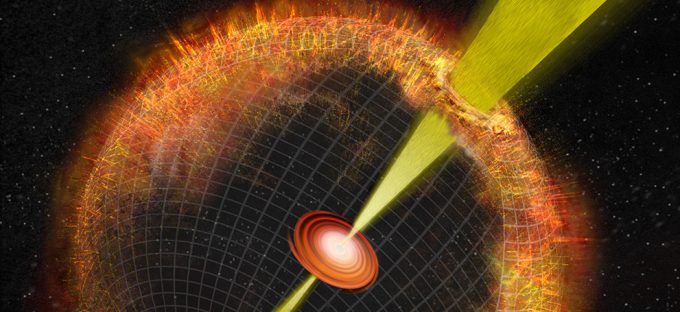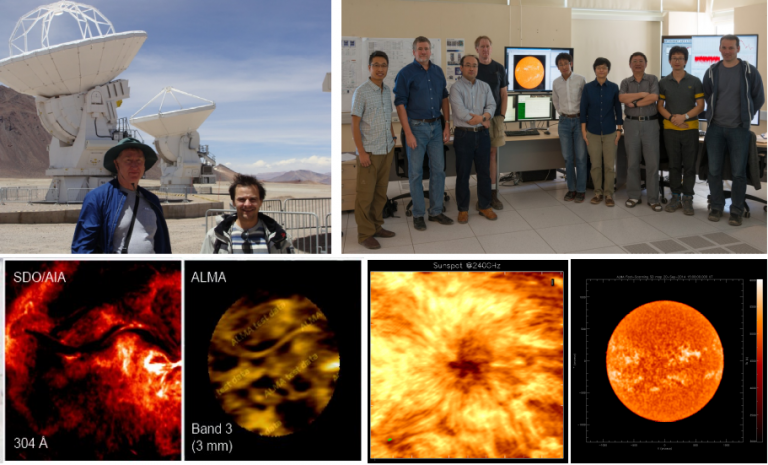News
March 2019
A salty young star in Orion
 A team of astronomers and chemists using the Atacama Large Millimeter/submillimeter Array (ALMA) has detected the chemical fingerprints of sodium chloride (NaCl) and other similar salty compounds emanating from the dusty disk surrounding Orion Source I, a massive, young star in a dusty cloud behind the Orion Nebula. "When we look at the information ALMA has provided, we see about 60 different transitions - or unique fingerprints - of molecules like sodium chloride and potassium chloride coming from the disk. That is both shocking and exciting," said Brett McGuire, a chemist at the NRAO in Charlottesville, Virginia, and co-author on the paper. More...
A team of astronomers and chemists using the Atacama Large Millimeter/submillimeter Array (ALMA) has detected the chemical fingerprints of sodium chloride (NaCl) and other similar salty compounds emanating from the dusty disk surrounding Orion Source I, a massive, young star in a dusty cloud behind the Orion Nebula. "When we look at the information ALMA has provided, we see about 60 different transitions - or unique fingerprints - of molecules like sodium chloride and potassium chloride coming from the disk. That is both shocking and exciting," said Brett McGuire, a chemist at the NRAO in Charlottesville, Virginia, and co-author on the paper. More...
Organic molecules around a young star
 Astronomers using ALMA have detected various complex organic molecules around the young star V883 Ori. A sudden outburst from this star is releasing molecules from the icy compounds in the planet forming disk. The chemical composition of the disk is similar to that of comets in the modern Solar System. Sensitive ALMA observations enable astronomers to reconstruct the evolution of organic molecules from the birth of the Solar System to the objects we see today. More...
Astronomers using ALMA have detected various complex organic molecules around the young star V883 Ori. A sudden outburst from this star is releasing molecules from the icy compounds in the planet forming disk. The chemical composition of the disk is similar to that of comets in the modern Solar System. Sensitive ALMA observations enable astronomers to reconstruct the evolution of organic molecules from the birth of the Solar System to the objects we see today. More...
Studying 100,000 star factories in 74 galaxies
 PHANGS-ALMA, an unprecedented and ongoing research campaign, is measuring a staggering 100,000 individual stellar nurseries spread throughout 74 galaxies. It has has already amassed a total of 750 hours of observations and given astronomers a much clearer understanding of how the cycle of star formation changes, depending on the size, age, and internal dynamics of each individual galaxy. This campaign is ten- to one-hundred-times more powerful (depending on your parameters) than any prior survey of its kind. More...
PHANGS-ALMA, an unprecedented and ongoing research campaign, is measuring a staggering 100,000 individual stellar nurseries spread throughout 74 galaxies. It has has already amassed a total of 750 hours of observations and given astronomers a much clearer understanding of how the cycle of star formation changes, depending on the size, age, and internal dynamics of each individual galaxy. This campaign is ten- to one-hundred-times more powerful (depending on your parameters) than any prior survey of its kind. More...
ALMA studies a new type of cosmic blast
 Astronomers have detected an explosion that's faster than known supernovae, and ALMA has revealed that it's brighter at millimetre wavelengths than other explosive events. The explosion was discovered by the ATLAS all-sky survey system in Hawaii, and immediately got the attention of astronomers. First, it was unusually bright for a supernova explosion - a common source of such outbursts. In addition, it brightened, then faded, much faster than expected. "If it is a supernova, then it is unlike any supernova we have ever seen," Ho said. The object's range of colors, or spectrum, she said, "doesn't t look like a supernova at all." In addition, it was brighter in millimeter waves - those seen by ALMA - than any other supernova. More...
Astronomers have detected an explosion that's faster than known supernovae, and ALMA has revealed that it's brighter at millimetre wavelengths than other explosive events. The explosion was discovered by the ATLAS all-sky survey system in Hawaii, and immediately got the attention of astronomers. First, it was unusually bright for a supernova explosion - a common source of such outbursts. In addition, it brightened, then faded, much faster than expected. "If it is a supernova, then it is unlike any supernova we have ever seen," Ho said. The object's range of colors, or spectrum, she said, "doesn't t look like a supernova at all." In addition, it was brighter in millimeter waves - those seen by ALMA - than any other supernova. More...
Older news
June 7, 2018
![]()
Vývoj režimu slunečních pozorování observatoře ALMA úspěšně dokončen
V aktuálně probíhajícím pozorovacím Cyklu 5 provádějí pracovníci výzkumné infrastruktury EU-ARC.CZ zpracování a kontrolu kvality dat z nedávného pozorování Slunce interferometrem ALMA. More...
May 23, 2018

ALMA Cycle 6 submission statistics available
In the Cycle 6, the demand for using the most advanced radio telescope in the world set a new record, surpassing 1800 proposals. A detailed report of the Cycle 6 Proposal Submission Statistics is now available. More...
May 15, 2018

ALMA Finds Most-Distant Oxygen in the Universe
Astronomers detected a faint but definite signal of oxygen in a galaxy located 13.28 billion light-years away from us, through observations using the Atacama Large Millimeter/submillimeter Array (ALMA). More...
May 3, 2018

ALMA Reaches 1000 Published Papers
The Atacama Large Millimeter/submillimeter Array (ALMA) has reached an important milestone with the publication of the 1000th peer-reviewed paper using ALMA data. More...
Vývoj režimu slunečních pozorování observatoře ALMA úspěšně dokončen
June 7, 2018
V aktuálně probíhajícím pozorovacím Cyklu 5 největšího astronomického přístroje současnosti – radiového interferometru ALMA – provádějí pracovníci výzkumné infrastruktury EU-ARC.CZ zpracování a kontrolu kvality dat z nedávného pozorování Slunce. Zredukovaná data zobrazená metodou interferometrické syntézy poté budou prostřednictvím centrály Evropského regionálního centra ALMA (EU ARC) se sídlem v ESO v Garchingu u Mnichova odeslána vedoucím jednotlivých pozorovacích projektů, kteří následně začnou s jejich vědeckou analýzou. Pozorování Slunce nabízí observatoř ALMA odborné veřejnosti teprve ve druhém pozorovacím cyklu. Na přípravě tohoto speciálního režimu pracoval několik let mezinárodní tým Solar ALMA Development Team složený ze zástupců ESO, severoamerické NRAO a japonské NAOJ. Výzkumná infrastruktura EU-ARC.CZ v něm jakožto jediný uzel evropské sítě ALMA s expertizou v oblasti slunečních radiových pozorování zastupovala celou Evropu. V roce 2015 také EU-ARC.CZ získala od ESO podporu v podobě projektu typu Enhancement and Optimization of (ALMA) Capabilities s názvem Solar Research with ALMA. Tento projekt byl úspěšně dokončen na konci loňského roku a celkový přínos evropského zastoupení pod vedením EU-ARC.CZ k vývoji slunečního pozorovacího režimu získal od oponentního panelu velice kladné hodnocení. Článek shrnující vývoj speciálního režimu, který umožnil observatoři ALMA pozorovat Slunce, vyšel v aktuálním vydání časopisu ESO The Messenger (číslo 171, 2018).
Celý článek vyšel na www.vyzkumne-infrastruktury.cz

ALMA Cycle 6 submission statistics available
May 23, 2018
In the Cycle 6, the demand for using the most advanced radio telescope in the world set a new record, surpassing 1800 proposals. A detailed report of the Cycle 6 Proposal Submission Statistics is now available. The report provides a summary of items such as the number of submitted proposals and time requested, subscription rates, and comparisons with the number of hours requested in previous Cycles. The new cycle begins in October this year and ends in September 2019. 4000 hours of the 12-m Array time and 3000 hours of the Atacama Compact Array (ACA) time, also known as the Morita Array, will be available for successful proposals. The science ranking process will take place in Tokyo, Japan, between June 18-23.
Number of Submitted Proposals and Time Requested:
Time requested (hours) |
||||
Number |
12-m |
7-m |
TP |
|
All proposals |
1838 | 19,696 | 10,941 | 7117 |
ACA standalone |
112 | - | 3672 | 1523 |
Large programs |
18 | 1830 | 1603 | 1315 |
Polarization |
101 | 1015 | - | - |
Solar |
32 | 124 | 124 | 124 |
ToO |
23 | 203 | 29 | 0 |
VLBI (3mm) |
9 | 69 | - | - |
VLBI (1mm) |
11 | 138 | - | - |
Subscription Rates:
Europe |
North America |
East Asia |
Chile |
All |
|
12-m array |
6.2 | 4.3 | 4.5 | 3.0 | 4.9 |
7-m array |
4.2 | 3.3 | 3.1 | 3.0 | 3.6 |
TP |
2.6 | 2.1 | 2.9 | 1.1 | 2.4 |
ALMA Finds Most-Distant Oxygen in the Universe
May 15, 2018
Source: http://www.almaobservatory.org
Astronomers detected a faint but definite signal of oxygen in a galaxy located 13.28 billion light-years away from us, through observations using the Atacama Large Millimeter/submillimeter Array (ALMA). Breaking their records, this marks the most distant oxygen ever detected in the Universe. Referencing infrared observations, the team determined that star formation in the galaxy started at an unexpectedly early stage: 250 million years after the Big Bang.
"I was thrilled to see the signal of the most distant oxygen,” explains Takuya Hashimoto, the lead author of the research paper published in the journal Nature and a researcher at Osaka Sangyo University and the National Astronomical Observatory of Japan.“This detection pushes back the frontiers of the observable Universe."

ALMA Reaches 1000 Published Papers
May 3, 2018
The Atacama Large Millimeter/submillimeter Array (ALMA) has reached an important milestone with the publication of the 1000th peer-reviewed paper using ALMA data. The paper was Spatial variations in Titan’s atmospheric temperature: ALMA and Cassini comparisons from 2012 to 2015 by Alexander E. Thelen et al. — which presents a detailed investigation of the atmospheric temperature of Saturn’s largest moon, Titan.
